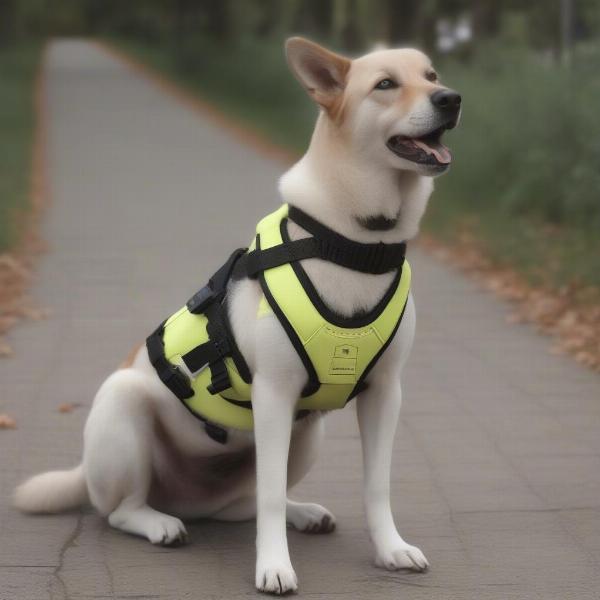A bicycle dog harness is a specialized piece of equipment designed to safely and comfortably secure your dog to your bicycle, allowing you to enjoy cycling with your furry friend. Whether you’re a seasoned cyclist or just starting out, choosing the right bicycle dog harness is crucial for ensuring a pleasant and safe experience for both you and your dog. This article will guide you through the process of selecting the perfect harness, along with essential tips for training and safety.
Choosing the Right Bicycle Dog Harness
The ideal bicycle dog harness should prioritize safety, comfort, and control. Look for a harness made of durable, weather-resistant materials with strong stitching and secure buckles. The harness should fit snugly but not restrictively, allowing your dog to move comfortably while preventing them from escaping or becoming entangled. Consider your dog’s size, breed, and activity level when selecting a harness.
 Different Types of Bicycle Dog Harnesses
Different Types of Bicycle Dog Harnesses
There are various types of bicycle dog harnesses available, including those that attach to the handlebars, frame, or seat post. Handlebar attachments are generally less stable and may interfere with steering, while frame attachments offer better control and stability. Seat post attachments are a good option for smaller dogs.
Training Your Dog to Use a Bicycle Dog Harness
Introducing your dog to a bicycle dog harness requires patience and positive reinforcement. Start by allowing your dog to wear the harness around the house for short periods, gradually increasing the duration as they become more comfortable. Reward them with treats and praise for positive behavior.
Next, introduce your dog to the bicycle. Let them sniff and explore the bike while wearing the harness. Once they are comfortable, begin walking alongside the bike while holding the leash attached to the harness. Gradually increase your walking speed as your dog adjusts.
Safety Tips for Cycling with Your Dog
Safety should always be your top priority when cycling with your dog. Ensure your dog is visible to other cyclists and vehicles by using reflective gear and lights. Avoid cycling in extreme weather conditions, and always carry water for your dog. Start with short rides and gradually increase the distance and duration as your dog’s fitness improves.
Never tie your dog’s leash directly to the bicycle, as this can cause serious injury if your dog suddenly pulls or stops. Always use a specialized bicycle dog harness and attachment. Be mindful of your dog’s body language and take breaks when necessary.
Conclusion
A bicycle dog harness can be a fantastic way to enjoy the outdoors and exercise with your furry friend. By choosing the right harness, training your dog patiently, and prioritizing safety, you can create a positive and enjoyable cycling experience for both of you. Remember to always consult with your veterinarian before starting any new exercise program with your dog.
FAQ
- What age can a dog start using a bicycle dog harness? It’s generally recommended to wait until your dog is at least one year old and their growth plates have closed before using a bicycle dog harness.
- Can I use a regular dog harness for cycling? No, regular dog harnesses are not designed for cycling and can be unsafe. Always use a specialized bicycle dog harness.
- How do I know if the harness fits my dog correctly? The harness should fit snugly but not restrict your dog’s movement. You should be able to fit two fingers between the harness and your dog’s body.
- What should I do if my dog pulls while cycling? Stop cycling and address the pulling behavior using positive reinforcement training.
- How far can I cycle with my dog? Start with short rides and gradually increase the distance as your dog’s fitness improves. Always monitor your dog for signs of fatigue.
- Is it safe to cycle with my dog in traffic? Be extra cautious when cycling with your dog in traffic. Use reflective gear, lights, and stay aware of your surroundings.
- What type of bicycle dog harness is best for a small dog? Seat post attachments or specialized harnesses designed for small breeds are often a good choice.
For further information on dog harnesses, you might find these articles helpful:
About ILM Dog
ILM Dog provides expert advice and resources on all aspects of dog care, from breed selection and puppy care to senior dog health and training. We offer comprehensive guides on nutrition, grooming, exercise, and travel, helping dog owners worldwide provide the best possible care for their canine companions. Our focus on health, behavior, and product recommendations ensures your dog’s well-being. Contact us for personalized advice: Email: [email protected], Phone: +44 20-3965-8624.